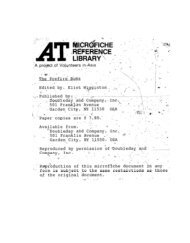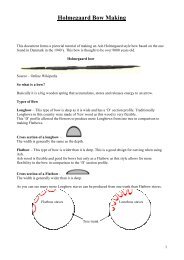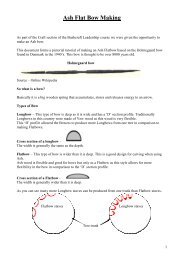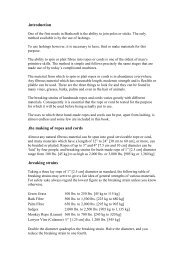Experiments on Knife Sharpening John D. Verhoeven ... - BushcraftUK
Experiments on Knife Sharpening John D. Verhoeven ... - BushcraftUK
Experiments on Knife Sharpening John D. Verhoeven ... - BushcraftUK
You also want an ePaper? Increase the reach of your titles
YUMPU automatically turns print PDFs into web optimized ePapers that Google loves.
lade of Fig. 33 al<strong>on</strong>g part of the length shown, does c<strong>on</strong>tain regi<strong>on</strong>s where the widthincreases from around 0.35 micr<strong>on</strong>s to around 0.6 micr<strong>on</strong>s.These results indicate that as the 2β edge angle is dropped from 40 o to 20 o itbecomes more difficult to sharpen blades to the same edge quality. This probably resultsfrom the reduced thickness of the blade at locati<strong>on</strong>s just behind the edge. This reducedthickness will increase bending stresses of the sharpening operati<strong>on</strong> which can lead tobending and cracking of the metal al<strong>on</strong>g the edge. Hence, the more gentle abradingacti<strong>on</strong> of the waterst<strong>on</strong>e over the 220 grit wheels becomes more of an advantage at thelower 2β angles.C<strong>on</strong>clusi<strong>on</strong>s1 In the as-ground c<strong>on</strong>diti<strong>on</strong> both the Tormek 220 grit wheel and the waterst<strong>on</strong>ewheel produce fold-over burs clearly visible in the face views, with the burs much larger29








